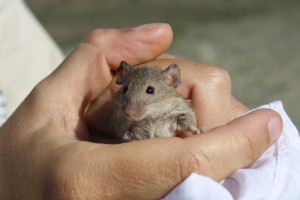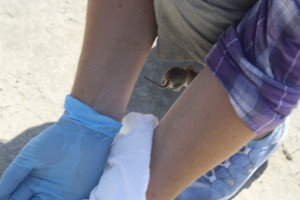I’ve spent a good chunk of time over the past 2 months putting out small mammal traps to catch rodents at different field sites in coastal Louisiana. My goal is to understand the prey base of local carnivores and then figure out if they are being selective about what they eat or simply taking prey as they find it. Most of the time I catch marsh rice rats and house mice (although ghost crabs seem irresistibly drawn toward the metal boxes- they always throw the cotton balls out before taking up residence); the rats are a native species we expect to see in Louisiana coastal habitats, the mice were originally stowaways with humans on the move.
During my most recent trapping session, I was talking with one of the site employees about my work. When she found out I was trapping rodents, she said, “Oh, good- I hope you get rid of a bunch of them.” I was a bit surprised by that reaction. Seeing the look on my face, she then said, “Do you release them?” Since I want to understand how these rats and mice are part of the entire coastal ecosystem and interact with carnivore species, I don’t want to remove them through trapping because that would distort relationships and population abundance. I want to know what species are there, have a relative sense of abundance, and then figure out what that means for carnivores. I use live Sherman traps to trap rodents; I take body and weight measurements, determine species and sex, and then let them go (sometimes they expedite the process through active resistance- a friend got a pretty nice picture of a mouse in mid-escape).
Her reaction got me thinking about the human-rodent relationship and our shared history and how we tend to view them with fear and/or disgust. It wasn’t until I helped with small mammal research in Bolivia that I realized that rats could be cute (an Oecomys trinitatus even featured on my Christmas card that year). The rats I catch here in Louisiana range from scraggly looking to adorable, but that’s not the way that many people see them because they are rats, and we know that rats can be invasive species destroying the eggs of native birds or they can be carriers of disease or, if you’re familiar with Mrs. Frisby and the Rats of NIMH, they can be almost creepily intelligent.
And now I’m wondering about the status of native rodent species around the world- are they all adaptable to human presence and the environmental changes we’ve created, or are some species in trouble? And are we actually paying attention to them as a conservation issue or just looking at them as pests in every ecosystem?
So this month I’ll be digging into the rodent world, trying to understand the conservation issues connected with rats and mice. It may be that everything I find relates to black and Norwegian rats invading seabird colonies and spreading diseases, but it may also be that some species are dependent on specific habitats we have altered or eliminated. So, even if it gives you the creeps a bit to think about these animals, hopefully I can provide a more complete view of their ecology and situation around the world.


